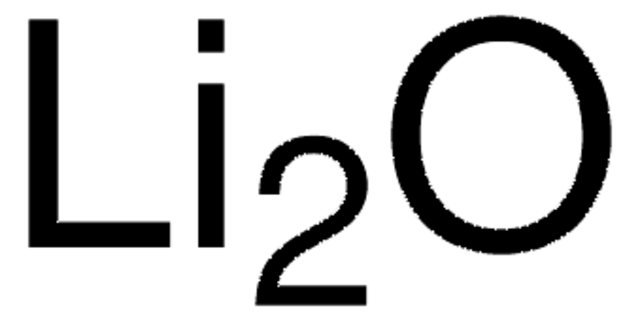931942
Lithium carbonate
battery grade, ≥99.9% trace metals basis
Sinónimos:
Lithium carbonate, Carbolithium, Carbonic acid lithium salt
About This Item
Productos recomendados
grade
battery grade
Quality Level
assay
≥99.9% trace metals basis
greener alternative product characteristics
Design for Energy Efficiency
Learn more about the Principles of Green Chemistry.
sustainability
Greener Alternative Product
mp
618 °C (lit.)
greener alternative category
SMILES string
[Li+].[Li+].[O-]C([O-])=O
InChI
1S/CH2O3.2Li/c2-1(3)4;;/h(H2,2,3,4);;/q;2*+1/p-2
InChI key
XGZVUEUWXADBQD-UHFFFAOYSA-L
¿Está buscando productos similares? Visita Guía de comparación de productos
General description
Lithium carbonate is an important industrial chemical, primarily as a precursor to lithium fluoride and lithium hydroxide, key precursors for compounds used in lithium-ion batteries. It is also used directly in ceramic glazes, glasses, and fireworks, among other industrial applications.
Lithium carbonate is produced in several ways, usually involving extracting lithium from the earth. One common extraction method involves mining and acid leaching from spodumene ores (lithium aluminum silicate). The ore is concentrated, baked at high temperature to change the crystal structure to a digestible phase, then digested with sulfuric acid to form a concentrate. Reacting the lithium sulfate concentrate with sodium carbonate forms the raw lithium carbonate that is further purified and dried. Another method involves processing and purifying underwater brine, which is pumped to the surface and dried by passive evaporation. The resulting salts are converted to lithium carbonate and subsequently purified.
Application
Packaging
500 g in poly bottle
signalword
Warning
hcodes
Hazard Classifications
Acute Tox. 4 Oral - Eye Irrit. 2
Storage Class
13 - Non Combustible Solids
wgk_germany
WGK 1
flash_point_f
Not applicable
flash_point_c
Not applicable
Elija entre una de las versiones más recientes:
Certificados de análisis (COA)
Lo sentimos, en este momento no disponemos de COAs para este producto en línea.
Si necesita más asistencia, póngase en contacto con Atención al cliente
¿Ya tiene este producto?
Encuentre la documentación para los productos que ha comprado recientemente en la Biblioteca de documentos.
Nuestro equipo de científicos tiene experiencia en todas las áreas de investigación: Ciencias de la vida, Ciencia de los materiales, Síntesis química, Cromatografía, Analítica y muchas otras.
Póngase en contacto con el Servicio técnico






